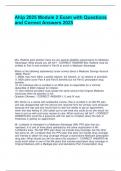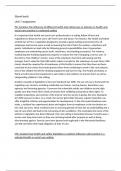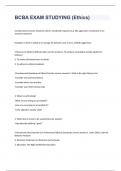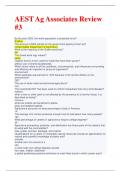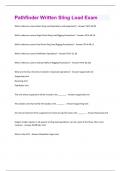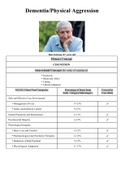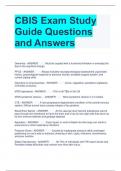Chapter 1: Introduction
Overview of business activities
The valuation of an equity security must begin with a thorough analysis of the entity’s underlying
business activities. Business activities can be divided into three broad categories:
1. Operating activities
a. Activities that are directly related to the provision of goods and services to customers
b. Primary means through which the owners of the business hope to make a profit
2. Investing activities:
a. Purchases and sales of resources that provide productive capacity with respect to the
nature of the goods and services that the firm is in the business of providing (e.g.
buying an oven is an operating activity for a cooking equipment retailer, but an
investing activity for a restaurant)
b. Involves resource commitments that are expected to provide benefits over long
periods of time
c. The investments a company makes today may be used to support future operating
activities that differ from the current operating activities (e.g. entering a new line of
business)
d. In the long run, operating and investing activities are closely linked
3. Financing activities
a. A firm can finance the operating and investing activities in many different ways
without affecting the nature of the activities
b. Firm can add value to create the opportunity for the owners of the business to
leverage the return from their operating and investing activities, to minimize taxes
and transactions costs, and to exploit inefficiencies in capital markets
Overview of equity valuation theory
Equity securities are financial instruments and their value is equal to net present value of the future
cash distributions. The valuation model of equity:
1. Value of equity as the net present value of the expected future dividend payments = the
dividend-discounting model
∞
Cash dividend
P 0= ∑
t =1 ( (1+r )t )
P0 = the value of the common equity at time 0
Cash dividend = expected amount of cash dividends to be paid in period t
R = discount rate
2. Value of equity as net present value of the expected future dividend payments including
stock repurchases and equity issuances
∞
Cash dividend+ Stock repurchases−Equity issuances
P 0= ∑
t =1 ( (1+r )t )
Stock repurchases = amount of cash to be paid out via stock repurchases in period t
Equity issuances = amount of cash to be raised via equity issuances in period t
Cash dividend + stock repurchases – equity issuance = net distribution to equity holders
Equity holders are the owners of the business and have the residual claim on the net cash flows
available from a business’s operating, investing, and non-equity financing activities. But in reality, the
1
,distributions to equity holders are made at the discretion of management, based on a variety of
factors. The cash flows generated by business’s operating activities are the key driver of distributions
to equity holders
The role of financial statements
Role of financial statements is to provide a detailed description of the financial consequences of a
firm’s historical business activities financial statements summarize the past operating, investing
and financing activities of a firm, and show how these activities affect the past, present and expected
future cash flows. Financial statements have two roles in the forecast:
1. Provide the language for translating forecasts of future business activities into forecast of
future cash flows
a. Provide information on how the various operating, investing, and financing activities
of a firm combine to produce cash flows
2. Provide a good starting point for forecasting the cash flow implications of future business
activities by describing the cash flow implications of past business activities
a. For the forecast, start with the past financial statements and then modify those
statements based on the changes that are anticipated
b. However, past financial statements can be a poor predictor in e.g. start-ups and firms
that make significant changes in their business activities
Three steps of equity valuation
The equity valuation process can be divided into three distinct steps:
1. Understanding the past
a. Need to understand the firm’s financial results in the context of its business strategy
and the industry and economy in which it operates
2. Forecasting the future
a. Forecasting the financial statements from which the estimates of future cash
distributions to equity holders will be derived
3. Valuation
a. Convert the estimates of future distributions to equity holders in a single estimate of
firm value
Understanding the past
1. Information collection
2. Understanding the business: aimed at developing a detailed understanding of the business
activities the firm is engaged in (e.g. what does the business make and how, competitors,
industry, business strategy)
3. Accounting analysis: to develop a thorough understanding of how the economic
consequences of firm’s business activities are reflected in the financial statements and helps
you understand the key strengths and weaknesses of the statement
a. Net cash flows of a firm over short periods of time provide a noisy signal of the long-
run cash flow consequences of a firm’s business activities solution: accrual
accounting: objective is to provide a better indication of the long-run cash flow
consequences of a firm’s short-run business activities
4. Financial ratio analysis: show how the components of a firm’s financial statements interact to
produce the overall financial performance (e.g. which profit margin, how much investment is
required to generate the sales) identify the key drivers of financial performance
5. Cash flow analysis: understanding the cash flows from a firm’s operating, investing, and
financing activities
Forecasting the future
Goal: forecast the future financial statements
2
, 1. Income statement forecast: concern operating activities (“Sales” most important)
2. Balance sheet forecast: concern the impact of the operating, investing, and financing
activities on the resources and obligations of a firm two tasks:
a. Forecast the resources and obligations necessary to sustain the forecasted operating
activities from our income statement
i. Operating activities require investments in working capital, long-term capital,
and obligations
b. Forecast the resources and obligations associated with the firm’s financing activities
(e.g. financial resources and non-equity financing)
Involves determining the amount and mix of financing that is used to support the firm’s
operating and investing activities
3. Cash flow forecast: cash flows represent the economic consequences of business activities
a. Includes forecasts of the net cash distributions to equity holders
b. Use income statements and balance sheet forecasts to construct cash flow forecasts
4. Final step: apply the same ratio analysis and cash flow analysis to the pro forma financial
statements (= forecasted financial statements)
a. Provides a reality check on the plausibility of the forecasts
Valuation
1. Cost of capital or discount rate: most important valuation parameter, but much
disagreement concerning the selection of an appropriate cost of capital
a. Choose whether to discount the cash distributions directly to equity holders:
i. Using the cost of equity capital; or
ii. Whether to discount cash flows to all providers of capital (i.e. common
equity plus preferred stock and debt) using a weighted average cost of
capital and then subtract the value of the non-equity capital to derive equity
value
iii. Both should give the same answer
2. Valuation models done in eVal
a. Residual income models
b. Discounted cash flow models
c. Both should give the same answer
3. Valuation ratios: communicates the value of the firm (e.g. price-to-earnings, PEG)
4. Complications:
a. Negative equity values: real world stock prices cannot be negative
b. Abandonment option: if the equity valuation is positive and the sensitivity analysis is
negative, then consider the abandonment option
c. Possibility that a firm may create or destroy value through transactions in its own
mispriced securities
d. Contingent equity claims: provide holders with the option to purchase shares of
common stock for a pre-specified exercise price, can result in new equity securities
being issued for consideration less than fair value
Chapter 2: Information Collection
Introduction
- A forecast is only as good as the information that is used to construct it so, the more
relevant information you collect, the more accurate the forecast will be
3
, Company information
SEC fillings
Public companies issuing securities in the US are required to file a number of detailed financial
reports with the Security and Exchange Commission (SEC), which in turn makes these reports
available to the public via EDGAR
- These SEC fillings represent the most important source of company-specific information and
provide the natural starting point for the collection of company data
- Important SEC fillings: Form 10-K (annual report), Form 10-Q (quarterly financial report),
Form 8-K (current report), etc.
Form-10K
- Usually the most relevant SEC filing for forecasting and valuation
- Domestic publicly traded companies are required to file this form within 60 to 90 days of
their fiscal year end, depending on their size
- Basic format:
1. The description of the business (e.g. key products sold, key customers, sources of
raw materials, competitive conditions, regulations, and risks)
2. Description of the property of the company
3. Description of any material pending legal proceedings against the company
4. Description of any matters submitted during the fourth quarter to a vote of
security holders
5. Summary information concerning recent stock price and dividend activity
6. Summary financial data for the last five years
7. Management’s discussion and analysis of the firm’s financial conditions, results
of operations, off-balance-sheet arrangements, contractual obligations, and
critical accounting policies MD&A
7A. Disclosures about the company’s exposure to certain market risks, such as
interest rate risk and currency risk
8. Company’s financial statements (annual balance, income statement, statement
of stockholders’ equity and statement of cash flows) and supplementary data
(detailed description of significant accounting policies, detailed supporting notes
and schedules, and the external auditor’s opinion on the financial statements)
9. Information about changes in and disagreements with the independent auditors
on accounting practices and financial disclosures
9A. Attest of the effectiveness of the company’s controls over its financial
reporting system
most important parts are 1, 7, and 8
Form 10-Q
- Quarterly version of Form 10-K
- Must be filled within 40-45 days of the end of the quarter, for each of the first three quarters
of the fiscal year
- Contain:
o Summary version of MD&A
o Abbreviated, unaudited financial statements
Form 8-K
- To report significant current events on a timely basis (e.g. change in control of a company,
acquisition or disposition of a significant portion of the company’s business operations,
bankruptcy, change in auditors, resignation of key directors or officers)
- These earnings announcements provide timely updates on financial performance, but are
voluntary disclosures by management that could be made up
4




